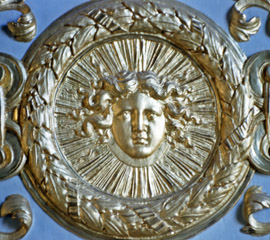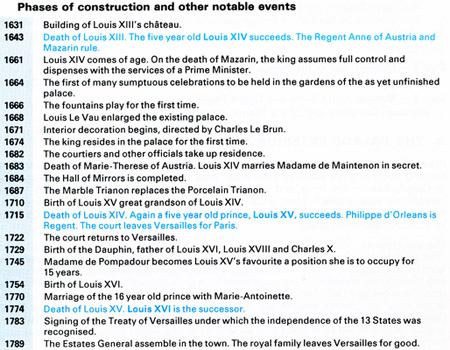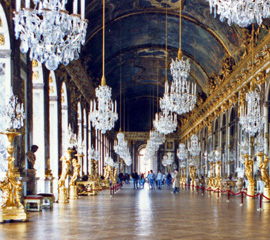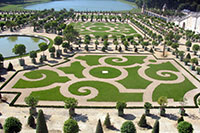Prior to 1662, the French royal family used Versailles
merely as a hunting retreat. Louis XIII built a simple chateau able to accommodate
himself and a small entourage. The surrounding area of Versailles was nothing
more than a small country village. It was not until the reign of Louis XIV that
Versailles became the quintessential European palace that other monarchs longed
for. Louis XIV disliked and distrusted
Paris. Louis XIV desired to create a lavish residential community for himself and the French government. With the government housed in one area, the Sun King could exert complete control over a centralized government.Therefore, he moved the French government from Paris to Versailles in
1682. The Sun King needed a residence befitting his grandeur. The chateau de
Versailles still stands today, as a reflection of the grand empire of Lois XIV.

The symbol of the Louis XIV, the Sun King
Most of the construction of the gardens and the grounds
occurred between 1668 and 1684. Louis XIV constructed Versailles through four
building campaigns. Besides the Sun King, three men were mostly responsible for
the design of the palace. Louis Le Vau served as the main architect on the
project. Charles Le Brun designed the interior of the seven hundred-room
palace. Andre Le Notre designed the lavish landscaping around the palace.

A timeline from the literature given to visitors of Versailles.
Louis Le Vau designed the palace of Versailles using French Baroque
style of architecture. French Baroque architecture inserts grand details upon
orderly, symmetrical buildings. Large curved forms, twisted columns, high
domes, and other complicated shapes characterize this type of architecture. The exterior is reminiscent of classical
Greek and Roman designs.
The interior of the palace of Versailles equals the grandeur
of the architecture. Charles Le Brun created the Louis XIV style, which
includes red and gold brocaded fabrics, marbling and many other lavish interior
details. The best example of this style
and Brun’s most famous room is the Hall of Mirrors. This main gallery of the
palace features seventeen mirrored arches reflecting seventeen arcaded windows,
each looking out to the gardens. To emphasize the power of the French monarch,
Louis the XIV commissioned Brun to paint the splendors of French government on
the ceiling. Louis the XIV is depicted as a Roman Emperor, a great ruler over
many foreign kingdoms.

The Hall of Mirrors
The gardens surrounding the palace are some of the most
famous pieces of landscaping in history. The garden at the Versailles palace is
Europe’s largest palace garden covering 250 acres of land. Andre Le Notre
designed a series of geometric paths, bushes, trees, and flowerbeds with many
statues adorning the gardens. Louis XIV insisted on created impressive water
displays throughout the gardens. Andre Le Norte executed this vision through
the construction of several fountains. The Fountain of Apollo and the Latonia
Basin were not only artistic masterpieces but for their time were technological
advanced hydraulic masterpieces. These fountains could not be supplied with
enough water to run for more than special occasions.


The highlight of the garden is the Grande Canal. It measures
1500 meters long by 62 meters wide. Louis XIV sought to recreate the canals of
Venice by bringing in gondolas and gondoliers. The “little Venice” housed these
imports and yachts. The Grande canal also served as a holding tank for the
water drained from the fountains to later be used to water the gardens.

Unfortunately, during the revolution the temporary
government auctioned off many of the pieces of artwork and furniture. The French
government did not seriously seek to regain these pieces until World War
II. The palace of Versailles is not only
famous for its architectural and artistic beauty. Versailles witnessed several key historic
events, including the Treaty of Paris - ending the American Revolution, proclamation
of Kaiser Wilhelm I as Emperor of Germany, and the Treaty of Versailles -
ending WWI.
For More Information
“1682 Versailles,
capital of the kingdom.” Chateau De
Versailles. http://en.chateauversailles.fr/history/the-great-days/most-important-dates/1682-versailles-capital-of-the-kingdom
(accessed on March 14, 2014).
“Architecture,
Sculpture, and Decoration at Versailles.” Boundless.
https://www.boundless.com/art-history/europe-in-the-1600s-56eae394-9a18-46de-abfa-883be84660c0/france--3/architecture-sculpture-and-decoration-at-versailles/
(accessed on March 15, 2014).
“Château de
Versailles, France.” World Site
Guides.com. http://www.worldsiteguides.com/europe/france/chateau-de-versailles/
(accessed on March 14, 2014).
Jarus, Owen.
“Palace of Versailles: Facts and History.” Live
Science. http://www.livescience.com/38903-palace-of-versailles-facts-history.html
(accessed on March 14, 2014).
“Palace of
Versailles and its Gardens.” Irvine
Valley College. http://www.ivc.edu/academics/schoolFA/arthistory/Documents/VERSAILLES_Fall_05/architecture.html
(accessed on March 13, 2014).
“Versailles.” Historylines. http://www.historylines.net/history/17th_cent/versailles.html
(accessed on March 14, 2014).
“Versailles
Palace: Chateau de Versailles.” A View on
Cities. http://www.aviewoncities.com/paris/versailles.htm (accessed on March 14, 2014).

